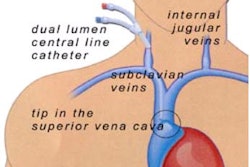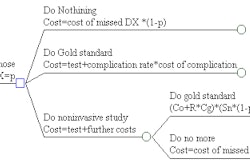SALT LAKE CITY - Standard MR angiography is considered the workhorse modality for vascular screening. But patient motion, in-plane saturation, and a prolonged scan time make it a less-than-perfect modality for the interventional radiologist who has higher aspirations for vascular imaging.
"Understanding the basic principles of contrast-enhanced MR angiography (MRA) and its performance is crucial for any interventional radiologist who is involved in the diagnosis and treatment of vascular disease," according to Dr. Thong Nguyen and Dr. Fong Tsai from the University of California, Irvine.
In a poster presentation at the Society of Interventional Radiology (SIR) meeting, the duo offered a simplified approach to contrast-enhanced MRA, designed for the non-MRI specialist. They gathered the data for this how-to poster from 50 contrast-enhanced MRA exams performed at their institution from 1997 to 2000. The exams were obtained from head to toe on a 1.5-tesla scanner with fast spoiled gradient echo, a stepping table, power injector, and bolus-chasing capability, they explained.
The authors stressed that acquisition can be performed during a 20-25-second breath-hold. This makes MRA particularly useful in patients who are unable to withstand a longer scan time.
"The high-resolution capability of this technique allows it to compete reliably with conventional catheter angiography," they explained. But they warned that "a higher-resolution scan demands more scan time, which indirectly creates artifacts and lessens the ability (of the patient) to breath-hold."
The following are some highlights from their poster, which outlined 7 basic steps for MRA scans on a standard mid-to-high-field scanner:
Obtain a good localizer scan
A regular MR scan prior to MRA can be used as a localizer, although several localizer scans may be required if the vascular territory is too large to be included in one field-of-view (FOV).
The sagittal scan should be used as the localizer for the coronal contrast-enhanced MRA, and vice-versa.
Define adequate imaging volume and FOV
Make sure the volume is correctly aligned to vascular territory as seen on the localizer scan, as a pseudo-occlusion or stenosis can be created when the vessel of interest is misaligned and subsequently cut off from imaging volume, they explained.
In a multistation exam, the scan table can be autotranslated or manually moved between scan acquisitions.
Select optimal sequences and parameters
Understanding modifications to spatial resolution, scan time, and signal intensity is key, the authors said. For spatial resolution, a higher matrix size means higher resolution, a drop in signal, and an increase in scan time. When it comes to whittling down scan time, select the minimum TR or TE, which will also improve contrast resolution, they said. Finally, the use of surface or phase-array coils will improve signal intensity and signal-to-noise ratio.
Determine accurate gadolinium bolus timing
A power injector is the right tool for a first-pass, single-dose IV bolus of gadolinium. The authors recommended injecting the contrast medium via an antecubital vein at a dose of 2-3 cc/sec and 0.1-0.2 mmol/kg. A saline flush would follow.
"Only one shot at it is allowed, since this is a first-pass study" Nguyen and Tsai cautioned. "Once the contrast has been injected, there is no return to the beginning for re-scan or adjusting parameters."
Data acquisition and central k-space organization
The center of k-space determines contrast, while the periphery of k-space affects spatial resolution.
The dry run
The authors suggested performing a test scan without contrast to assess the patient’s breath-hold ability and to ensure adequate coverage. Even if the exam does not require breath-hold, testing the scan time will prevent venous contamination on the late image.
Performing contrast-enhanced MRA
Be sure to offer breathing instructions to the patient and practice breath-hold before the scan, they said. Also, be willing to balance or compromise scan time with spatial resolution, volume, and intensity.
Finally, the authors offered some pitfalls of MRA, such as pseudo-occlusion or pseudo-stenosis; venous contamination; and, of course, the presence of ferromagnetic artifacts.
"CE MRA is a powerful diagnostic tool, which is now universally available," they said in their conclusion. They added that the interventional radiologist possesses the greatest understanding of vascular anatomy and pathology, so this specialist is in a unique position to adopt MRA and hone the technique.
They also urged their fellow interventional radiologists to develop a "familiarity with the MRI/MRA jargon, (which) is valuable, especially when working in collaboration with the MRI staff."
By Shalmali Pal
AuntMinnie.com staff writer
March 30, 2003
Copyright © 2003 AuntMinnie.com



















